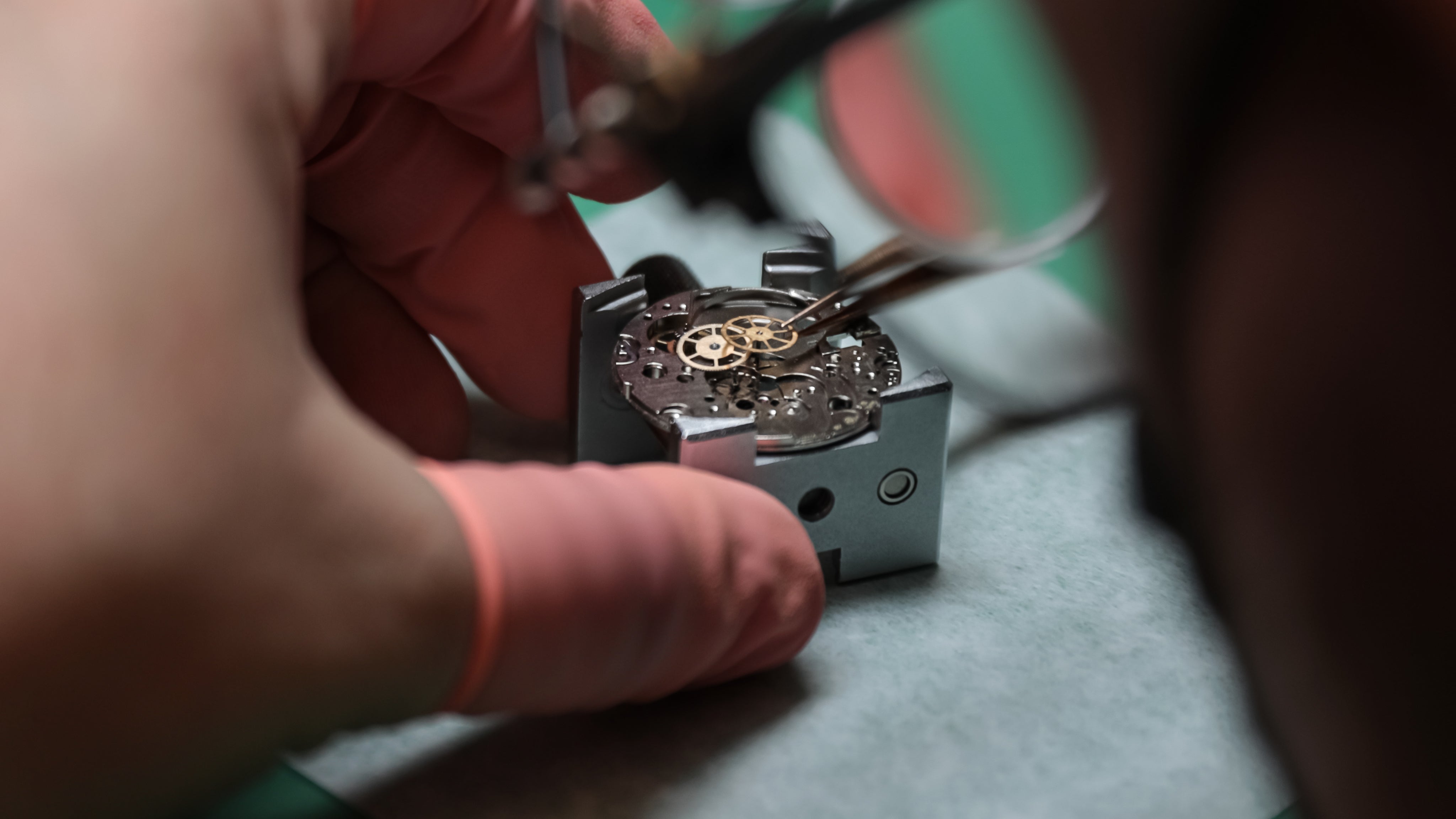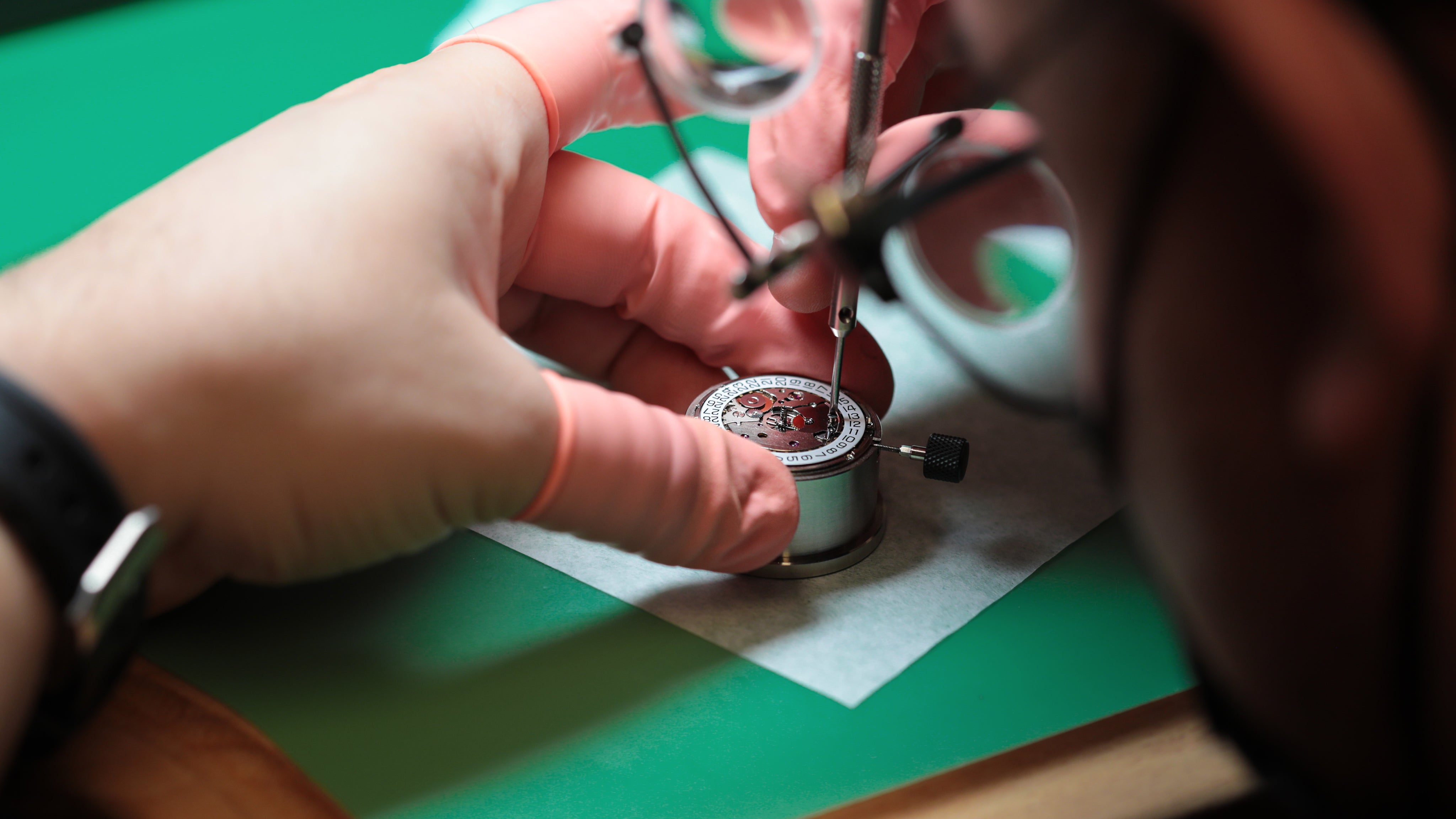
BUILT TO LAST
Marathon timepieces are built to last a lifetime. As with any automatic watch, the movement is complex and requires proper care and maintenance. Whether you're a first-time purchaser, or a long-time owner, our tips below will help keep your Marathon Automatic #bestinthelongrun
UNBOXING YOUR AUTOMATIC
Welcome to the family and congratulations on your new Marathon Automatic Watch. Here are some tips to keep your new addition running strong:
Use wrist movement to wind the watch when you first unbox it. This will allow the movement to wake gradually.
Never set the date between 9 and 2. One of the most important rules is not to set the date if the watch’s time is between 9pm and 2am. Note, this is based on the time shown on the watch, not the actual time of day. At 9pm, the date-changing mechanism starts to engage the gear train and only disengages after 2am. Setting the date during this period can break off the intricate teeth of the mechanism and require repair.
Give the watch time to adjust. Allow the watch to adjust to your body temperature and daily activity. The accuracy and precision of the movement continues to improve over time.
Built for daily wear and tear. Your Automatic Watch is built to be worn, wear it daily for optimal performance.
Always set it forward. During events such as daylight-savings, you might be inclined to wind your watch back an hour, however this can put undue stress on the movement of your watch. Always move the hands forward to reach your desired time setting.
Dive and swim with confidence. Ensure the crown of the watch is fully secured before exposing it to any water. Once secured, our SAR (Search & Rescue) Dive Watches are rated for 30ATM and are fully water resistant to a depth of 300 meters (1000 feet).
Consult the good book. Be sure to read your manual to fully understand the care of your specific Marathon model. If you have questions, ask our trained team of professionals. We’re here to ensure you get the most out of your timepiece.

THE FIRST 3-6 MONTHS
You’ve had your Marathon Automatic for a while now and it’s seen its fair share of adventures. Here are a few tips on how to keep your co-pilot ticking:
Let the watch wind itself whenever possible. If you need to wind the watch after a long period of inactivity, give the crown 5-10 spins until the second hand starts moving. Keep hand winding to a minimum, as over-winding could have a negative effect on the winding mechanism.
Never wind your watch while on the wrist. This may add tension to the mechanism.
Keep the movement active. Not wearing your automatic watch regularly? Invest in a quality watch winder to keep the movement active. If you don’t invest in a watch winder, the original box or a watch roll is the best place to store your watch. Try to remember to wind it at least once a week and keep it in a dry, temperature-controlled place.
Clean your watch regularly. We recommend using rubbing alcohol, a toothbrush and a microfibre cloth.
Take advantage of your 2 Year Warranty. Every newly purchased Marathon Watch comes with a quality guarantee covering the timepiece for any manufacturing defects within the first two years of its life. Our expert team at customerservice@marathonwatch.com is dedicated to making sure your timepiece is running in tip-top shape.
CONTINUED CARE AFTER ONE YEAR
It may have a few marks on it, but your Marathon is as reliable as the day you got it. Here’s how to keep it in excellent shape:
Don’t ignore your servicing. Our timepieces are built to last a lifetime when properly maintained, sending your watch in for regular servicing every 5-7 years will help to keep your automatic movement running with Marathon-level precision. With time, gaskets can dry out and compromise the water resistance of the watch if they are not changed and/or lubricated. A full-servicing includes a change of crystal, crown and back gasket to keep your water resistance at the optimal rate. For servicing requests, contact our team directly at customerservice@marathonwatch.com or use a trusted watch repair shop.
Keep a weathered eye. Contact customerservice@marathonwatch if you notice any issues or irregularities with your timepiece. We hold our watches to a high standard, even in their later years. Our team of watch experts is standing by to assist you with any complications.
WATCH PARTS GLOSSARY
MAINSPRING: The mainspring is the power source of automatic watch movements. When the crown of an automatic watch is wound, kinetic energy is transferred to the coil mainspring. As more energy is stored, the mainspring becomes tighter and tighter, storing more energy for later use.
ROTOR: The rotor is a metal weight that looks like a half-circle. The rotor is attached to the movement and swings freely as your wrist moves. As your wrist moves the rotor transfers power to the mainspring and twists it, storing the energy.
BALANCE WHEEL: The balance wheel is an internal component that beats in a circular motion, at five to ten times per second. In combination with the hairspring, the balance wheel makes a back-and-forth rotation movement six or eight times per second (depending on your model).
GEAR TRAIN: The energy stored within the mainspring is allowed to pass through the gear train, which is a small series of internal gears that make the watch hands and other parts of the watch face move.
ESCAPEMENT: The escapement regulates the power that is coming through the movement. Without it your watch would spin out of control.
DIAL TRAIN: The dial train is another series of gears similar to the gear train. The dial train transfers equal parts of energy from the balance wheel into the watch hands, enabling the hands to move.
JEWELS: Jewels are synthetic rubies that are put in the center of a gear to keep it in continuous motion and prevent wear-and-tear from heat and friction.
CROWN: On the side of the watch is a small wheel, called a crown. The crown is turned, which winds the watch and enables it to run.
CLUTCH: When the mainspring is fully wound, a clutch attached to the rotor is engaged. The clutch prevents the rotor from winding the mainspring further.



1 comment
Hello I am looking at purchasing a Marathon GSAR. The control number is 29754060 with serial number 733. I was hoping you could tell me information regarding this watch and also when maintenance might be due. Also the cost of the maintenance possibly suggested. Thank you so much.
Mathis Hamilton
Leave a comment